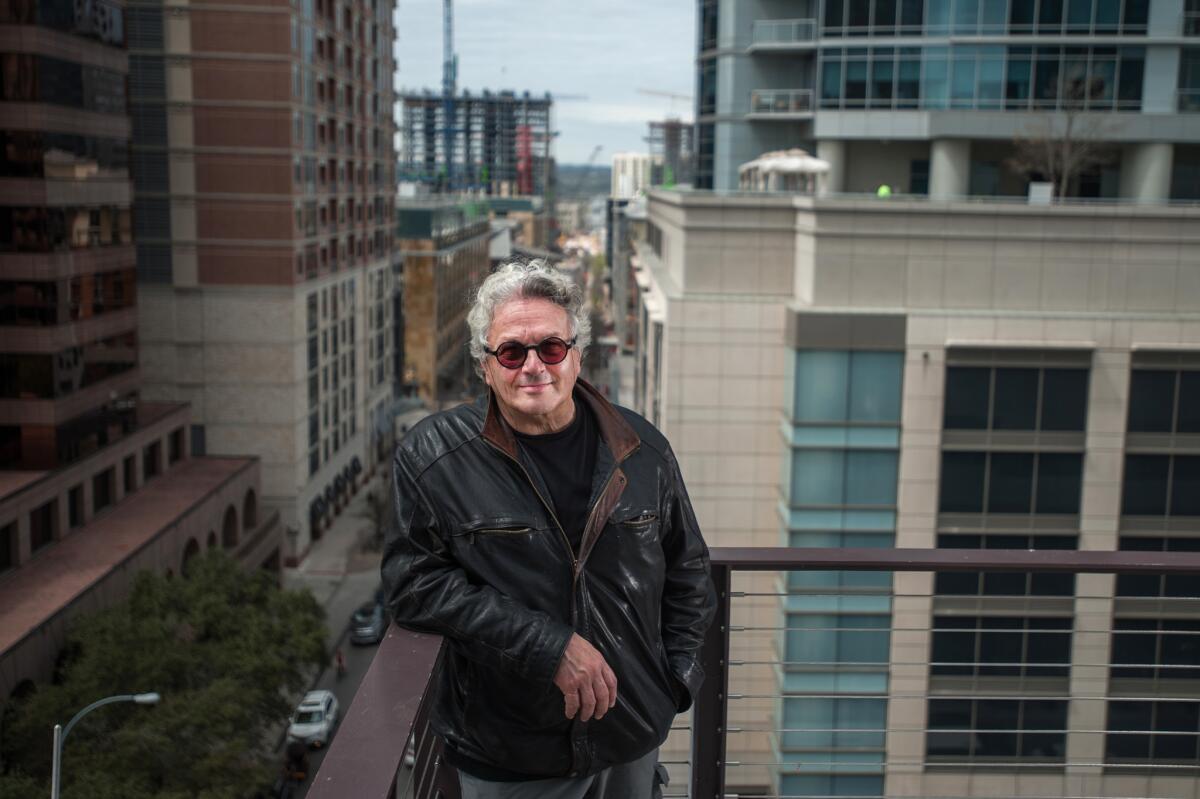Can ‘Mad Max: Fury Road’ maintain awards momentum to crash the Oscars?

“Mad Max: Fury Road” director George Miller, photographed on an Austin, Texas, rooftop at the South by Southwest Film Festival in March.
- Share via
It seems as if nothing with George Miller’s “Mad Max: Fury Road” is as it should be: It’s a relentless action movie that played at one of the world’s most prestigious film festivals. It’s the fourth film in a long-running franchise, but the first in 30 years. It introduces a new star in the title role. It’s a summer movie that finds itself an unexpected year-end critical darling. Following years of setbacks and delays, it now feels ferociously up to the minute.
Even though it was released back in May, the movie has been nudging its way further into the year-end awards conversation. It has been steadily picking up critics awards and top-10-list mentions, won six prizes at the recent Australian Academy of Cinema and Television Arts Awards, and on Thursday morning was nominated for Golden Globes in the motion picture drama and director categories.
Golden Globes 2016: Full Coverage | Complete list | Snubs, surprises and reactions | Top nominee photos
The big question now is whether that “Fury Road” momentum can roll on to Oscar nominations. Could this really happen, or is this just a case of the pre-Oscar prognosticator and precursor circuit inventing a narrative they’d like to see but with no basis in Academy Awards reality?
Earlier this year Vin Diesel was largely dismissed after predicting that the heartfelt action juggernaut “Furious 7” would win best picture. He sharpened his point by adding that “unless the Oscars don’t want to be relevant ever.” Large-scale action movies, the stuff of summer rather than fall and winter, are typically serviced at the Oscars in technical/craft categories such as visual effects, sound or cinematography without breaking through in main categories such as picture or director.
“Skyfall,” part of another long-running franchise, picked up five Oscar nominations and won two, while Christopher Nolan’s “Inception” garnered eight nominations, including best picture, on its way to winning four in the craft categories.
And Miller is not a total outsider to the Academy of Motion Picture Arts and Sciences. He is already an Oscar winner, having picked up a statue for best animated film with “Happy Feet.” He was nominated twice for “Babe,” which even picked up a best picture nomination back in the days of only five nominees. Miller was also nominated for his screenplay for “Lorenzo’s Oil.” However, Miller has never been nominated by either the producers or directors guilds, which have become increasingly important signposts for anyone hoping to forecast the Oscars.
Another possibility could find “The Martian” and director Ridley Scott competing for a nomination against “Fury Road” and Miller, if there is in fact only one slot in voters’ minds for a more commercial, less obviously Oscar-y title. “Star Wars: The Force Awakens” could also potentially take those slots.
Imagine every bad thing -- war, energy crisis, food and water crisis, natural disaster -- happening all at once, and then moving forward from there some 45 years. The previous three films happened somewhere in there (don’t overthink the chronology), leading Max to the opening of the new film.
In “Mad Max: Fury Road” the wasteland wanderer of the film’s title is played by Tom Hardy, replacing Mel Gibson who starred in the previous three films. A tyrant known as Immortan Joe (Hugh Keays-Byrne) controls water for a vast population and keeps a cadre of young women for reproductive purposes. Those women are assisted in escaping his fortress by Imperator Furiosa (Charlize Theron), who drives them across the desert in an immense tanker truck. After coming across Max out in the wasteland, they form a reluctant alliance.
Alongside its spectacular driving and stunts, the film takes the radical shift of moving Max into a supporting position to allow Furiosa to largely propel the story. The film drives both its action and its storytelling in parallel, giving the movie a hurtling sense of forward motion. As Miller himself put it during an interview earlier this year in Austin, Texas, at the South by Southwest Film Festival, “Normally in movies you have the talking bits and the action bits and a break between them. Here’s it’s all together.”
It says something of Miller’s boldness with his narrative universe, as well as Max’s new position in it, that Max’s now-iconic car is destroyed in a chase. This is going to be something different, Miller seems to be saying. In a world of reboots, prequels and stand-alones, there is something refreshing in the way Miller approached his source material, grappling with it head-on.
“A revisit? Can we invent a new term?” responded Miller back in the spring when asked how he would define the new film in terms of the earlier films in the “Mad Max” universe. He added, “it has this intense familiarity, at the same time it was a new thing. The world had changed so much; I’d changed, cinema had changed, audiences had changed and it became a new thing.”
Follow on Twitter: @IndieFocus
Follow The Times’ complete coverage of the Golden Globes and Oscars
More to Read
Sign up for The Envelope
Get exclusive awards season news, in-depth interviews and columnist Glenn Whipp’s must-read analysis straight to your inbox.
You may occasionally receive promotional content from the Los Angeles Times.







